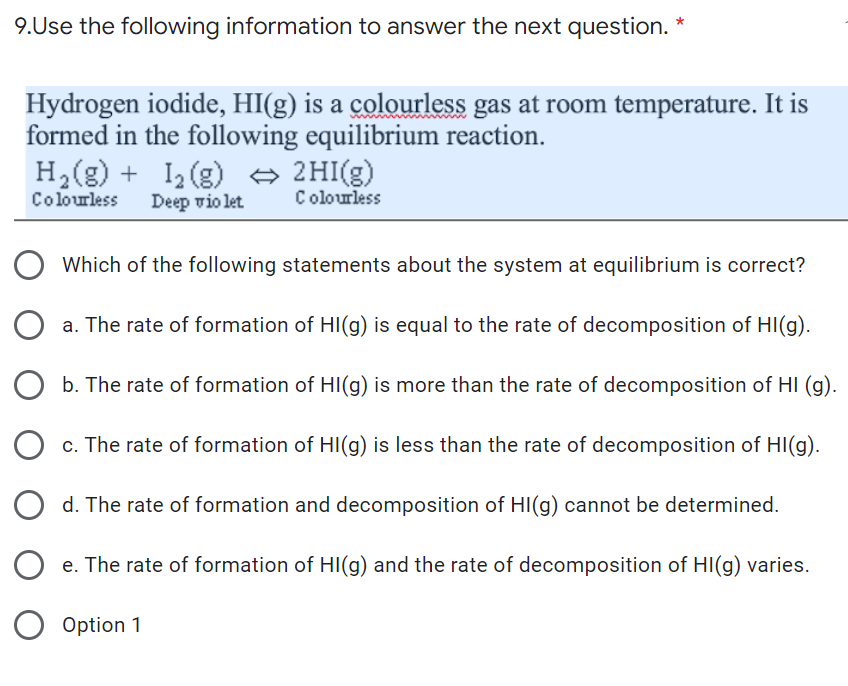9.Use the following information to answer the next question. * Hydrogen iodide, HI(g) is a colourless gas at room temperature. It is formed in the following equilibrium reaction. H₂(g) + 1₂(g) → 2HI(g) Colourless Deep violet Colourless O Which of the following statements about the system at equilibrium is correct? a. The rate of formation of HI(g) is equal to the rate of decomposition of HI(g). b. The rate of formation of HI(g) is more than the rate of decomposition of HI (g). c. The rate of formation of HI(g) is less than the rate of decomposition of HI(g). d. The rate of formation and decomposition of HI(g) cannot be determined. e. The rate of formation of HI(g) and the rate of decomposition of HI(g) varies. O Option 1
9.Use the following information to answer the next question. * Hydrogen iodide, HI(g) is a colourless gas at room temperature. It is formed in the following equilibrium reaction. H₂(g) + 1₂(g) → 2HI(g) Colourless Deep violet Colourless O Which of the following statements about the system at equilibrium is correct? a. The rate of formation of HI(g) is equal to the rate of decomposition of HI(g). b. The rate of formation of HI(g) is more than the rate of decomposition of HI (g). c. The rate of formation of HI(g) is less than the rate of decomposition of HI(g). d. The rate of formation and decomposition of HI(g) cannot be determined. e. The rate of formation of HI(g) and the rate of decomposition of HI(g) varies. O Option 1
Chemistry & Chemical Reactivity
9th Edition
ISBN:9781133949640
Author:John C. Kotz, Paul M. Treichel, John Townsend, David Treichel
Publisher:John C. Kotz, Paul M. Treichel, John Townsend, David Treichel
Chapter15: Principles Of Chemical Reactivity: Equilibria
Section: Chapter Questions
Problem 27PS: Dinitrogen trioxide decomposes to NO and NO2, in an endothermic process (rH = 40.5 kJ/mol-rxn)....
Related questions
Question
A2.

Transcribed Image Text:9.Use the following information to answer the next question. *
Hydrogen iodide, HI(g) is a colourless gas at room temperature. It is
formed in the following equilibrium reaction.
H₂(g) + 1₂(g) → 2HI(g)
Colourless Deep violet
Colourless
O Which of the following statements about the system at equilibrium is correct?
a. The rate of formation of HI(g) is equal to the rate of decomposition of HI(g).
b. The rate of formation of HI(g) is more than the rate of decomposition of HI (g).
c. The rate of formation of HI(g) is less than the rate of decomposition of HI(g).
d. The rate of formation and decomposition of HI(g) cannot be determined.
e. The rate of formation of HI(g) and the rate of decomposition of HI(g) varies.
O Option 1
Expert Solution
This question has been solved!
Explore an expertly crafted, step-by-step solution for a thorough understanding of key concepts.
Step by step
Solved in 2 steps

Knowledge Booster
Learn more about
Need a deep-dive on the concept behind this application? Look no further. Learn more about this topic, chemistry and related others by exploring similar questions and additional content below.Recommended textbooks for you

Chemistry & Chemical Reactivity
Chemistry
ISBN:
9781133949640
Author:
John C. Kotz, Paul M. Treichel, John Townsend, David Treichel
Publisher:
Cengage Learning

Chemistry & Chemical Reactivity
Chemistry
ISBN:
9781337399074
Author:
John C. Kotz, Paul M. Treichel, John Townsend, David Treichel
Publisher:
Cengage Learning

Chemistry: An Atoms First Approach
Chemistry
ISBN:
9781305079243
Author:
Steven S. Zumdahl, Susan A. Zumdahl
Publisher:
Cengage Learning

Chemistry & Chemical Reactivity
Chemistry
ISBN:
9781133949640
Author:
John C. Kotz, Paul M. Treichel, John Townsend, David Treichel
Publisher:
Cengage Learning

Chemistry & Chemical Reactivity
Chemistry
ISBN:
9781337399074
Author:
John C. Kotz, Paul M. Treichel, John Townsend, David Treichel
Publisher:
Cengage Learning

Chemistry: An Atoms First Approach
Chemistry
ISBN:
9781305079243
Author:
Steven S. Zumdahl, Susan A. Zumdahl
Publisher:
Cengage Learning


Chemistry
Chemistry
ISBN:
9781305957404
Author:
Steven S. Zumdahl, Susan A. Zumdahl, Donald J. DeCoste
Publisher:
Cengage Learning

Chemistry for Engineering Students
Chemistry
ISBN:
9781337398909
Author:
Lawrence S. Brown, Tom Holme
Publisher:
Cengage Learning